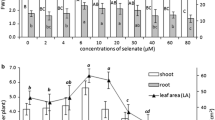Summary
One-centimeter root-tip segments submerged in phosphate buffer solutions (pH 4.5 to 5.5) were treated with Na2SeO3 concentrations ranging from 0.005 to 10.0 mM. Uptake of O2 and CO2 output were measured manometrically. Segments exposed aerobically to 1.0 and 10.0 mM selenite for several hours exhibited a considerable decrease in O2 input, particularly at the higher concentration. In contrast, CO2 output was greatly accelerated by selenite concentrations of 2.5 to 10.0 mM. Consequently respiratory quotient values were large for these high concentrations. Under conditions of marked O2 deficiency, CO2 output was appreciably decreased regardless of the presence or absence of selenite. Use of Se75 showed that the gas output with selenite did not include a volatile selenium compound. A striking parallel was indicated between concentration effects of selenite and published arsenite effects on aerobic fermentation. This was confirmed by including both selenite and arsenite treatments in the same experiments. re]19730427
Similar content being viewed by others
References
Beevers, H. and Gibbs, M., Position of C14 in alcohol and carbon dioxide formed from labeled glucose by corn root tips. Plant Physiol. 29, 318–321 (1954).
Beevers, H., Stiller, M. L., and Butt, V. S., Metabolism of the organic acids; In Plant Physiology, a Treatise. Ed. F. C. Steward. IV B, 119–262 (1966).
Bonhorst, C. W., Anion antagonism in yeast as indicators of the mechanism of selenium toxicity. J. Agr. Food Chem. 3, 700–703 (1955).
Girton, R. E., Sterilization of corn grains with sodium hypochlorite. Plant Physiol. 11, 635–639 (1936).
Girton, R. E., Respiratory drifts of maize roots. New Phytol. 57, 89–105 (1958).
James, W. O., The effect of 2,2′-dipyridyl on plant respiration. New Phytol. 55, 269–279 (1956).
Neal, M. J. and Girton, R. E., The Pasteur effect in maize. Am. J. Botany 42, 733–737 (1955).
Shrift, A., Microbial research with selenium; In Symposium: Selenium in Biomedicine. Ed. O. H. Muth. 241–271 (1967).
Shrift, A., Aspects of selenium metabolism in higher plants. Ann. Rev. Plant. Physiol. 20, 475–494 (1969).
Umbreit, W. W., Burris, R. H., and Stauffer, J. F., Manometric Techniques. Burgess Publ. Co. (1957).
Author information
Authors and Affiliations
Rights and permissions
About this article
Cite this article
Girton, R.E. Effects of selenite selenium on respiration in maize roots. Plant Soil 40, 119–127 (1974). https://doi.org/10.1007/BF00011414
Received:
Issue Date:
DOI: https://doi.org/10.1007/BF00011414




